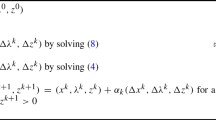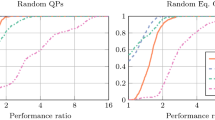Abstract
Long step interior-point methods in linear programming are some of the most efficientalgorithms from a computational point of view. We prove polynomial complexity of a classof long step target-following methods in a novel way, by introducing a new nonconvexpotential function and adapting the analysis framework of Jansen et al. [4, 6, 7]. The mainadvantage is that the new potential function has an obvious extension to semi-definiteprogramming, whereas the potential used in the above-mentioned papers does not.
Similar content being viewed by others
References
F. Alizadeh, Combinatorial optimization with interior point methods and semi-definite matrices, Ph.D. Thesis, University of Minnesota, Minneapolis, MN, 1991.
C.C. Gonzaga, Large steps path-following methods for linear programming, Part I: Barrier function method, SIAM Journal on Optimization 1(1991)268–279.
D. den Hertog, Interior Point Approach to Linear, Quadratic and Convex Programming, Algorithms and Complexity, Kluwer, Dordrecht, The Netherlands, 1994.
B. Jansen, Interior point techniques in optimization, Complementarity, Sensitivity and Algorithms, Kluwer, Dordrecht, The Netherlands, 1997.
B. Jansen, C. Roos and T. Terlaky, A polynomial Dikin-type primal-dual algorithm for linear programming, Math. of Operations Research 21(1996)341–353.
B. Jansen, C. Roos, T. Terlaky and J.-Ph. Vial, Primal-dual target-following algorithms for linear programming, Annals of Operations Research 62(1996)197–231.
B. Jansen, C. Roos, T. Terlaky and J.-Ph. Vial, Long-step primal-dual target-following algorithms for linear programming, Mathematical Methods of Operations Research 44(1996)11–30.
B. Jansen, C. Roos, T. Terlaky and J.-Ph. Vial, Primal-dual algorithms for linear programming based on the logarithmic barrier method, Journal of Optimization Theory and Applications 83(1994) 1–26.
M. Kojima, S. Mizuno and A. Yoshise, A primal-dual interior point algorithm for linear programming, in: Progress in Mathematical Programming: Interior Point and Related Methods, ed. N. Megiddo, Springer, New York, 1989, pp. 29–47.
M. Kojima, M. Shida and S. Shindoh, Local convergence of predictor-corrector infeasible-interiorpoint algorithms for SDPs and SDLCPs, Mathematical Programming 80(1998)129–160.
I.J. Lustig, R.E. Marsten and D.F. Shanno, Interior point methods: Computational state of the art, ORSA Journal on Computing 6(1994)1–15.
R.D.C. Monteiro, Primal-dual algorithms for semidefinite programming, SIAM J. Optimization 7(1997)663–678.
R.D.C. Monteiro and J.-S. Pang, On two interior point mappings for nonlinear semidefinite complementarity problems, Mathematics of Operations Research 23(1998)39–60.
Yu. Nesterov and A.S. Nemirovskii, Interior point polynomial algorithms in convex programming, SIAM Studies in Applied Mathematics, Vol. 13, SIAM, Philadelphia, PA, 1994.
L. Vandenberghe and S. Boyd, Semidefinite programming, SIAM Review, 38(1996)49–95.
Y. Zhang, On extending some primal-dual interior point algorithms from linear programming to semi-definite programming, to appear in SIAM J. Optimization (1998).
Rights and permissions
About this article
Cite this article
de Klerk, E., Roos, C. & Terlaky, T. A nonconvex weighted potential function forpolynomial target following methods. Annals of Operations Research 81, 3–14 (1998). https://doi.org/10.1023/A:1018913325452
Issue Date:
DOI: https://doi.org/10.1023/A:1018913325452




